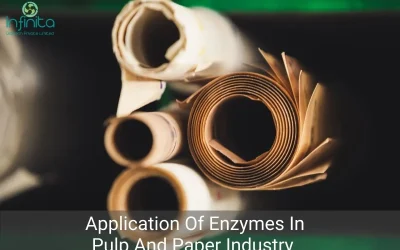The pulp and paper industry is constantly searching for innovative solutions to improve efficiency and reduce environmental impact. One area that holds great promise is enzyme technology. Enzymes, as natural catalysts, have the ability to enhance various processes in pulp and paper production. In this article, we will delve into the role of enzymes in the industry, explore the latest advances in enzyme technology, and discuss the impact of these innovations on the pulp and paper sector. Additionally, we will examine future perspectives for enzyme technology and its potential for sustainable pulp and paper production.
Understanding the Role of Enzymes in the Pulp and Paper Industry
Enzymes play a crucial role in the pulp and paper industry, where they act as catalysts to accelerate chemical reactions. Enzyme technology has been increasingly employed to improve the efficiency and sustainability of various processes. Let’s explore the basic science behind enzyme technology.
### The Basic Science Behind Enzyme Technology
Enzymes are proteins that facilitate chemical reactions by lowering the activation energy required for those reactions to occur. In the pulp and paper industry, enzymes are used to break down complex molecules such as lignin and cellulose, making them easier to process. This breakdown allows for a more efficient and cost-effective production process.
Enzymes are generally highly specific, meaning they are designed to target and interact with particular substances. This specificity allows enzymes to be tailored to the specific needs of the pulp and paper industry, addressing challenges such as reducing energy consumption and improving product quality.
The Evolution of Enzyme Use in the Industry
The use of enzymes in the pulp and paper industry has evolved significantly over the years. Originally, enzymes were primarily used for wastewater treatment and the removal of unwanted substances during the pulping process. However, with advancements in enzyme technology, their applications have expanded to other areas of production.
Today, enzymes are used in various stages of pulp processing, including bleaching, refining, and deinking. These enzymes offer advantages such as improved pulp quality, reduced chemical usage, and increased process efficiency.
One area where enzymes have made a significant impact is in the bleaching process. Traditionally, chlorine-based chemicals were used to bleach pulp, but these chemicals have negative environmental effects. Enzymes, on the other hand, offer a more sustainable alternative. They can effectively remove lignin and other impurities from the pulp, resulting in a brighter and cleaner final product. This not only improves the quality of the paper but also reduces the need for harsh chemicals.
In the refining stage, enzymes are used to break down the cellulose fibers further, increasing their flexibility and improving the paper’s strength. This allows for the production of stronger and more durable paper products. Additionally, enzymes can help reduce energy consumption during the refining process, making it more efficient and environmentally friendly.
Enzymes also play a crucial role in the deinking process, where they aid in the removal of ink particles from recycled paper. By breaking down the ink, enzymes make it easier to separate the ink from the paper fibres, resulting in a higher-quality recycled pulp. This not only helps in the production of high-quality recycled paper but also reduces the environmental impact of the paper industry by promoting recycling and reducing the need for virgin pulp.
As enzyme technology continues to advance, researchers are exploring new ways to enhance the efficiency and sustainability of the pulp and paper industry. From developing enzymes with increased specificity to optimizing their performance in different stages of production, the future of enzyme technology in this industry looks promising.
The Latest Advances in Enzyme Technology
Continuous research and development in enzyme technology have led to exciting breakthroughs in the field. Let’s explore some of the latest advances in enzyme technology and their potential impact on the pulp and paper industry.
Enzymes, the biological catalysts that drive essential chemical reactions, have undergone significant advancements in recent years. These developments have revolutionized various industries, including the pulp and paper sector, by enhancing efficiency, sustainability, and cost-effectiveness.
Breakthroughs in Enzyme Efficiency
Scientists and engineers have been working tirelessly to enhance the efficiency of enzymes used in the pulp and paper industry. Through genetic engineering and enzyme optimization techniques, enzymes can now perform their designated tasks at faster rates and under a wider range of conditions.
Moreover, the latest breakthroughs in enzyme technology have enabled the customization of enzymes to target specific substrates with precision. This level of specificity not only boosts efficiency but also minimizes waste by ensuring that enzymes only act on the desired compounds, leading to cleaner and more sustainable production processes.
These advances in enzyme efficiency translate into improved process productivity and reduced production costs. Enzymes that can work at lower temperatures, for example, result in energy savings and reduced environmental impact.
Novel Enzyme Applications in Pulp Processing
Enzyme technology continues to push the boundaries of what is possible in the realm of pulp and paper production. Novel enzyme applications are being developed to address specific challenges faced by the industry.
One of the most promising advancements is the use of enzymes in the modification of pulp fibers to enhance paper strength and quality. By precisely tailoring enzyme formulations, researchers have been able to improve paper properties such as tensile strength, tear resistance, and printability, opening up new possibilities for high-performance paper products.
For instance, enzymes capable of selectively removing ink particles from recycled paper fibers are being utilized in the deinking process. This not only improves the quality of recycled paper but also reduces the need for harsh chemicals, thereby minimizing environmental pollution.
The Impact of Innovative Enzyme Technology on the Pulp and Paper Industry
The implementation of innovative enzyme technology has a profound impact on the pulp and paper industry. Let’s explore two key areas where enzyme technology is driving positive change: enhancing production processes and reducing environmental impact.
Enhancing Production Processes
Enzymes offer significant advantages in terms of process efficiency and product quality. Their ability to break down complex molecules like lignin and cellulose results in improved pulp quality and increased fiber yield. This, in turn, leads to a more efficient and cost-effective production process.
But what exactly is lignin and cellulose? Lignin is a complex organic polymer that provides structural support to plant cells, while cellulose is a polysaccharide that forms the main component of plant cell walls. Enzymes, with their remarkable ability to target and break down these complex molecules, revolutionize the production processes in the pulp and paper industry.
Enzymes can also be used to modify the fiber properties, making them more suitable for specific paper grades. This level of control and customization opens up new possibilities for the industry, enabling the production of high-value specialty papers. Imagine a paper that is specifically designed to be more absorbent, or one that has enhanced strength for packaging purposes. Enzyme technology makes these advancements possible.
Reducing Environmental Impact
As sustainability becomes increasingly important, the pulp and paper industry must strive to reduce its environmental impact. Enzyme technology plays a vital role in this endeavor by offering greener alternatives to traditional chemical-intensive processes.
By replacing or reducing the use of harsh chemicals, enzymes help minimize water pollution and the release of harmful substances into the environment. This not only benefits the surrounding ecosystems but also ensures a safer working environment for the industry’s workforce.
Moreover, enzymes enable a more efficient use of resources and energy, contributing to the overall sustainability of the industry. For example, the use of enzymes can significantly reduce the amount of water required in the production process. This not only conserves a precious resource but also reduces the energy needed to treat and transport water.
Enzyme technology also has the potential to reduce the industry’s reliance on fossil fuels. By optimizing the production process and improving the efficiency of pulp and paper manufacturing, enzymes help decrease energy consumption and greenhouse gas emissions.
As we can see, the implementation of innovative enzyme technology in the pulp and paper industry brings about numerous benefits. From enhancing production processes to reducing environmental impact, enzymes are driving positive change and paving the way for a more sustainable and efficient industry.
Future Perspectives: The Potential of Enzyme Technology
The future of enzyme technology in the pulp and paper industry is bright. Ongoing research and development efforts are expected to lead to further technological advancements and new opportunities for innovation.
Predicted Technological Developments
Experts predict that future advances in enzyme technology will focus on improving enzyme stability and activity under harsh conditions. This would allow enzymes to be applied in a wider range of processes and environments, unlocking even more possibilities for the industry.
Furthermore, enzyme immobilization techniques are being explored to enhance enzyme reusability, reducing the need for frequent enzyme replenishment and further lowering production costs.
The Role of Enzyme Technology in Sustainable Pulp and Paper Production
Enzyme technology has a crucial role to play in the pursuit of sustainable pulp and paper production. By reducing reliance on chemical-intensive processes and improving resource efficiency, enzymes contribute to a more environmentally friendly industry.
As the demand for sustainable products continues to grow, enzyme technology will become increasingly important in meeting these expectations. Its potential to improve both the economic and environmental aspects of pulp and paper production positions enzyme technology as a key driver of innovation in the industry.
In conclusion, enzyme technology holds immense potential for unlocking innovation in the pulp and paper industry. With ongoing advancements, enzymes are transforming production processes, enhancing product quality, reducing environmental impact, and paving the way for sustainable pulp and paper production. As we look to the future, the role of enzyme technology in driving innovation in the industry is set to continue expanding, leading to a more efficient, sustainable, and prosperous sector.






